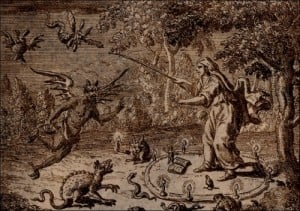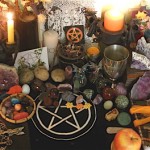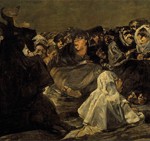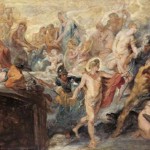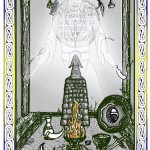Lately I found myself reasserting my opinion that there is nothing of much (any…) spiritual or occult value in ‘Satanism’, or the worship of the various beings known as Satan, Lucifer or the Devil, or in the occultism derived from self-labelled Satanism. This provoked a response from Jake Stratton-Kent, an author I give huge respect to (and frequently cite). His work in developing a modern Grimoiric spirit-arte cannot be neglected by anyone interested in the subject, and I take his opinions seriously. In this discussion his most telling assertion, to me, was that ignoring 1500 years of western occult culture by entirely discarding ‘Satan’ and the Grimoiric spirit hierarchy is counterproductive and irrational. He describes his own work, in which key Grimoiric ‘demons’ have become what I, as a polytheist/animist, would call the gods of his personal shrine in pretty convincing ways. It is clear that he has successfully created a home-cult that is different from that of a traditional polytheist only in the sourcing of its persons. Rather than drawing on the remnants of pre-Christian spirit-lore directly, as Neo paganismdoes, he has addressed the spirits in names and forms found in the 17th and 18th century grimoires. Is this ‘Satanism’? Is this ‘Paganism’? Does its success refute my assertion that there is no merit in Satanic ideas and occult tropes?
I do not file neo-grimoire work with my ‘Satanic, or ‘dark’ books. As a hobbyist I have kept up with the literature of ‘dark occultism’. Beginning with Grant in the 70s, through the Setians, and more recently Koetting, 218, Ford, Smith, and a variety of new-fangled Traditional Witchcraft authors, that literature is the basis for the opinions I hold about modern self-described LHP and ‘dark’ practices. Mainly I find their scholarship little better than the Llewellyn average, and find constructs such as “Lucifer, bringer of Freedom” to be as fluffy (i.e. modernist and based on questionable mythography) as the Triple Goddess. My reconstructionism-honed sense of discernment in such matters makes me a picky bitch.
Paganism and Satanism
Concerning my own preconceptions and prejudices, I’ll admit that this is more systematic thinking about the idea of ‘Satan’ than I have bothered to do for decades. My own spiritual goals have been centered on the restoration and establishment of polytheistic and animist worship, and the preservation and development of more esoteric spiritual practice *within* that public Pagan religion. Because there is no figure equivalent to my understanding of the Satanist’s god in traditional European pantheons, and because I find that the ‘War in heaven’ does not exist in traditional Euro-Pagan lore in the way it does in Christian (or Zoroastrian) myth I have simply rejected the assertion that Satan has any place in the kind of work I mean to do. Thus if a modern occult system works with the ‘worship of Satan’, or even includes the later ‘Hierarchy of Hell’ I consider it excluded from my personal work. That said I am committed to occultism in religion, and find the scholarship on the preservation of pre-Christian ritual forms in the grimoires both convincing and inspiring. It is their mythic construct I find it necessary to discard.
In my process of ‘moving north’ I (and, I think, a growing number of experimental occultists) have also left behind the late-classical synthesis and the Hermetic cosmos. The Archaic cosmos in which I attempt to work is a much more spiraled, center-to-edge sort of arrangement than the Hermetic ladder of lights (or layer of chains, if one is various sorts of gnostic). This sets aside the idea of ‘sub-lunar’ spirits, and makes the mythic title of ‘King of the Spirits of the Air’ less attractive to me. I cannot find Hell to be an adequate equivalent to the archaic Underworld, nor can I consign daemons of the gods and dead primarily to that underworld, nor place them in hierarchy under the Underworld’s king. All of this reduces my resonance with even the more occult versions of Satanism.
I do not find any serious use for the notion that there are great cosmic spiritual forces that wish to bind and restrict us as their slaves. The gods of European antiquity did not make such requirements and I see no sign of their modern persons doing so either. In my spiritual comprehension there is simply no such thing as the biblical, or late-Hellenic philosophical ‘God’, nor any non-Abrahamic (or Avestan which is an anomaly, if a powerful one) equivalent to it in traditional polytheism and animism. In the same way there is no traditional mythic equivalent of the King of the Powers of Air, except perhaps in specific local deities or sub-deities, none of whom are in opposition to the greater powers – that is, they are not ‘satanic’ in the Hebrew sense.
I think it is the War in heaven notion that gets in the way of allowing medieval spirit cosmology to sync well with more archaic (or non-Euro polytheist) systems. In my understanding of archaic story the War between the Gods and the Other Gods is fought at the dawn of time, and is functionally well-over in the time of living mortal cult. The Titanic forces are not only defeated, they are in fact in place within cosmos. Gods, heroes and magicians sometimes have to consult with them, sometimes marry them – Heroes are often born of such unions; their relationship includes cooperation as often as conflict. How that basic Indo-Euro motif became oppositionalized first in Zoroaster’s revelation and maybe more relevantly in Enoch’s story is a historical puzzle. I see no merit in internalizing that opposition. I would adopt no position in which any spirit – god or daemon or underworld rot-worm – must be my enemy. Light and Dark, Order and Chaos, Underworld and Heavens are lovers, not opponents.
For this reason I find no resonance with ‘anti-cosmic’ sentiments. I reject entirely the gnostic notion that reality, or matter, or society is a trap or prison, or other than our proper home. Knowing that I speak as a first-world kid I find no sense of oppression in life, and have built my spiritual work on celebrating matter and spirit as one great fun-fest. Sometimes the fun is a horror-movie, but never mind. This does not remove the reality of the dangerous kill-ya-and-eat-ya parts of nature or of the spirit-world. Traditional culture may characterize such beings in terms that get translated as ‘demons’, but that implies none of the assumptions of western theology or popular myth about that word. An Asura or a drowning-sidhe, or a Naga or Assyrian plague-demon is not a ‘Satanic’ being though it is, I think, a Pagan being in the sense of ‘polytheist and animist’.
Satanism and Witchcraft
Here we are in squishier ground, as the majority of the complex that the west thinks of as ‘witchcraft’ was invented by the Church, based first on their response to remnant Paganism, and later to the persistence of occult practice, even when re-clothed in Christian myth. The Dark Ages are called ‘dark’ primarily because we can’t see a damned thing about them. One of the hidden things is the 500 years of transition in religion and magical arts between, say 500 and 1000 ce. Late classical Pagan spirit-work transitions into proto-Solomonic work, remnants of Paganism that were prominent at the start have been driven deep or extinguished by the end, and literate record comes to be almost entirely owned by the Church for a short while. During that period remnant Paganism transitions into the beginning of ‘High Magic’ and folk-magic finds its mythology transforming toward the later grimoire synthesis.
The making of a pact with a spirit had been a core part of magic-art for centuries (maybe forever). In the theological transition the church asserted that any homage given to unauthorized spirits was functionally ‘devil-worship’. The gaining of a familiar by appealing to one of the ancient gods (or their equivalent in a transforming spirit-list) could not be perceived as anything but ‘Satanism’ by the church and became a core of the scholastic description of witchcraft. The fact that it probably fairly well described a real continuing tradition of magical practice can only have added to the confusion that accompanies transition.
As imperial Christianity has advanced across the world they have arrived in each new polytheistic/animist location with the message that ‘magic’ and ‘witchcraft’ – you know, divination, spirit-summoning, treating with the Dead, working your own will by spiritual arts – was forbidden, and in fact was ruled by ‘the devil’ or Satan. Functionally they learn that Satan is the god of magic and, especially, of down-home sorcery. Sensible people don’t give up useful, pro-survival tech, so those that continued to learn and teach sorcery eventually conformed to the legislated mythology, and Satan, Lucifer, Beelzebub, etc became the gods of sorcerers.
I think the witchcraft myth was shaped by two other big Pagan motifs – the secret circle of mystery initiates, and the big public sacrifice-feast. Both of these are undeniably present as part of pre-Christian Europe. The public feast as religious expression is present from Ireland to India. A tribe, king or rich patron undertakes a great sacrifice and ritual to gain some good – sons, or the relief of drought, etc. They parcel off a few acres, set up the fire-altars and begin sacrificing meat-animals and blessing beer. The villages empty out as the folk set up for what was sometimes weeks of feasting – a hecatomb doesn’t happen in a day. These were joyous occasions of free food and drink, social exchange (i.e. sex), song and dance for the peasant multitude, along with plenty of idol-worship, and probably lots of spell and divination commerce as well.
To this day the cities of northern Europe empty out, I’m told, on the occasion of Summer Solstice. The impulse to leave town, go to the country, sing, drink and play seems inescapable, and the church tried to quash it by painting the ‘witch’s revel’ – by which they meant the remnant Pagan tendency – as a feast of filth and cannibalism. Leaving Margaret Murray entirely aside I find it impossible not to think that in 800 ce or so the impulse among the peasants was stronger than today.
The mystery-cults of the Orphics seem to have been small circles of initiates who gathered in secret to work rites that might transgress the strict regimen of pure living that their religion otherwise recommended. Naked circles gathered around a fire, worshipping a goat-mask on an underworld staff, and teaching and learning practical magic as well as spirit-vision is one of the more esoteric expressions of traditional Pagan religion. The growing church must surely have seen and described it as devil worship.
In general, when the church says ‘devil worship’ from one place to another they aren’t talking about beings that the folk would have said were the same fellow. Any old local spirit was ‘the devil’ in their descriptions. Folkloric sorcery-seekers may have been going down to the crossroad and making a pact with some horned power-spirit for centuries before Christianity arrived (though we can’t prove it), but by the 1700s that horned lad was surely ‘de debbil’ in folk understanding, if without theological sophistication. Theology makes little difference to those seeking magical power, and if it was the devil to be called upon for it, then so be it.
I see no merit in internalizing the church’s description of these Old Ways as “Satanic”. I am uninterested in the idea constructs of the early-modern era in the west, and find the occultism of that period, and of the late grimoires, to be thoroughly grown-over by Christian myth and models that simply do not appeal. To move those systems out of their orthodox, demons-n-angels model into something more palatable seems to be taking Jake (bless him) down a road of scholarship and historical detection at least as winding as that required for the reconstruction of any earlier era. I simply prefer to focus my work on a period when there was no ‘Rebel Prince’ in myth, no ‘sublunar spirits’, no King of Demons and, in fact, no conflict between any spirit-faction and ‘god’. My rather serious amateur inquiry continues to convince me that all that was the case in archaic polytheism, as in most non-Euro tribal religions.
Once again, in our modern times and inside our occult and Neopagan revival the sense that meeting in secret cult circles is ‘forbidden’ or a ‘transgression’ just isn’t an issue. The involvement of Satan or of devils (as opposed to similar spirits understood in non-Christian mythic terms) seems irrelevant to me. Even those who approach occult work from a restrictive or dogmatic monotheist background have often carefully deconstructed themselves into atheism before turning back to more occult pursuits. I see no particular benefit in presenting spirit-based sorcery, pacts with gods, daemons and the dead, divination, naked bonfire dances or sex-magic as anything but a whole and holy part of spiritual work. In traditional polytheist and animist systems weird, occult practices are simply nested within the common practices of popular religion, and that’s my general goal for the future here in the west. There is no sense that the Dionysus of the mysteries was opposed to the order of Olympus – that is, he was not ‘Satanic’.
Transgression and Illumination
The use of transgressive techniques to bust through social programs and free the individual mind certainly predates, and occurs outside of, Christianity or post-Christian monotheism. While the tight social bonds of tribal society that constrained individual initiative did not come from the ‘word of the gods’, it was often granted the force of religious injunction. Religious specialist training, whether nunnish or tantric, often took initiates out of the patterns of common life. In some sects that was done by involving them in violations of deep societal moral assumptions about food, sex or some other core human thing. We see this in Greece and in India with some clarity, and we see suggestions of it (without proof) in European ‘witchcraft’ legends. Again in the latter it is difficult to distinguish the church’s exaggerations and fantasies from real folk practices and Pagan survivals.
Several branches of world mysticism and magic use deliberate transgression of moral law as a means of both spiritual illumination and of gathering magical power. It would be untrue to say that more ‘mainstream’ sects approve of or recommend such practices. Nevertheless they are part and parcel of the great religious traditions of the world.
It’s rather more difficult to use transgression for these goals in our modern western world. Being a 60-year-old child of the 60s I transgressed the crap outa my society’s values, not just for the pleasure of doing it but for the actual pleasure it brought. Occultism was a part of that transgression, but I just never found the material surrounding ‘Satanism’ to be very deep or interesting, compared to either High Magic with Qabalistic divine stuff or Euro-Pagan reconstructions. By the time I was 15 or so I had rejected Christianity and was more likely to take moral instruction from Uncle Crowley than from more orthodox scripture. So at this point transgressing against Christian values is a ho-hum, so what, sort of idea. While it isn’t true everywhere in the US, I have always lived in places where Christianity has little discernable social presence, and provides no wall against which to push back. It seems to me that in the West Christianity is a spent force, with little juice left in its symbols of rebellion.
In the same way my commitment to hippie and counterculture values has meant that I live outside of most capitalist models as well. I can count the days I’ve worn a suit on two hands (if you don’t count the obligatory outfits I was stuffed into for childhood church…). I have never valued money over leisure, and through my working life I limited my career options in order to pursue magic and my other financially unrewarding arts and delights.
I must say that I never associated too much of that with ‘witchcraft’, which I always understood as the effort to restore remnant Paganism, or with occultism which I understood to be the secret search for both power and enlightenment. While I understood intellectually that ‘Satanism’ was said to promote such thinking the two-bit anti-Christianity that was the most prominent rebellion of the day just didn’t have any percentage of the romance of post-Pagan forest cults. What the church would surely call ‘Satanic rebellion’ I have always simply called ‘religion’. My opinion about the matter is more likely to be true than the Pope’s, I think.
So today my Pagan and occult work (which has included thousand-person naked fire-revels, small-group sorcery, personal sex-magic, Saivite-Shakta puja-work, etc) centers on leading public, daytime fire-sacrifice rites that are open to the Pagan public. No nudity, no drunkenness (though some drinking), no deliberate transgression unless one counts the worship of idols, making of offerings, working of spells, jokes about the gods, etc as such. Our rites are full of families and their kids, for whom this polytheism-and-picnic community will become their childhood memory, free of guilt-trips and full of songs. I expect this sort of Paganism to grow into viable minority religious institutions, supporting householder lives not so different from those of more mainstream religionists.
In the woods beside this sunny meadow, or once the sun goes down, we could re-grow a transgressive practice. Ancient Paganism and modern polytheisms are supported and fertilized by the weird, underworld, occult sects *within* the religion. In the dharma, whether Hindu or Buddhist, LHP and RHP are partners and serve the same spiritual goals, often the same gods.
Our Neopaganism is still mainly based on an ethic of personal freedom. However to the degree that we succeed in building a ‘new culture’ we will build new walls and bindings of mutual agreement – morality. Such mutual cultural trance will inevitably become a barrier to self-awareness and personal growth, and the value of transgression as a spiritual technique will grow. Inside our stable, daylight Paganism we may find space for a new witchcraft. Successfully working the formula requires the former in order for the latter to work. My hope would be to see occult and esoteric cults and their more dangerous methods kept discreetly in the hidden pockets of the system; not so much in opposition to the daylight cult, but as its night-time lover.

